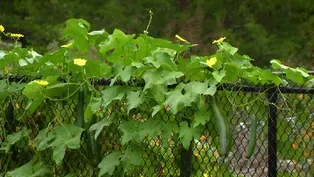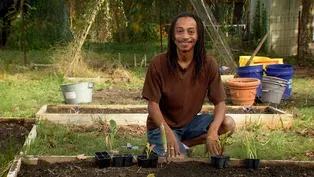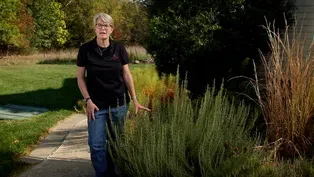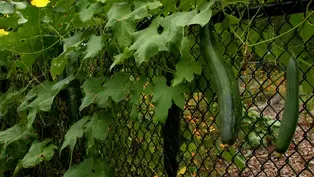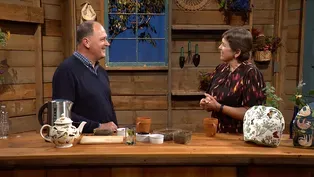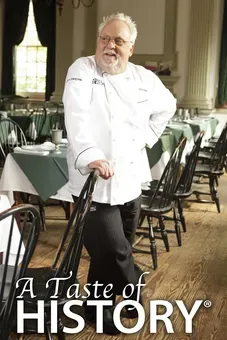Virginia Home Grown
Natural Sponges made from Luffa
Clip: Season 23 Episode 8 | 6m 34sVideo has Closed Captions
Learn how the luffa plant is processed to make a sponge
Lara Brooks explains how to determine when a luffa fruit is perfect for picking and shows how to remove the skin, seeds and meat to produce a xylem that can be used as a natural sponge. Featured on VHG episode 2308; October 2023.
Problems with Closed Captions? Closed Captioning Feedback
Problems with Closed Captions? Closed Captioning Feedback
Virginia Home Grown is a local public television program presented by VPM
Virginia Home Grown
Natural Sponges made from Luffa
Clip: Season 23 Episode 8 | 6m 34sVideo has Closed Captions
Lara Brooks explains how to determine when a luffa fruit is perfect for picking and shows how to remove the skin, seeds and meat to produce a xylem that can be used as a natural sponge. Featured on VHG episode 2308; October 2023.
Problems with Closed Captions? Closed Captioning Feedback
How to Watch Virginia Home Grown
Virginia Home Grown is available to stream on pbs.org and the free PBS App, available on iPhone, Apple TV, Android TV, Android smartphones, Amazon Fire TV, Amazon Fire Tablet, Roku, Samsung Smart TV, and Vizio.
Providing Support for PBS.org
Learn Moreabout PBS online sponsorshipSo Lara, that, to me, is the smallest luffa I've ever seen.
>>It is.
It's edible at this size, but that's not what we really want.
If we're here to process luffa into sponges, then we had to wait 90 days for this to grow into a full-sized luffa.
>>That's an eternity in the gardening world.
>>It is, it is that.
But then you have the hard decision about, when and how are you going to harvest?
So it's a little tricky.
Some people wait until it dries on the vine.
>>That is rock solid hard.
>>It is rock solid hard.
And if we were going to peel it, you could see that it is totally brown and brittle inside, and people would have to bleach it in order to get a nice sponge.
>>That looks painful.
>>Yes, actually.
And not a very nice end product.
So we're going for that nice end product.
So then you have the decision about, what are you going to harvest, and when?
>>Yes, yes.
>>So I try to keep track of it in the garden.
And you might be tempted, when it gets this big and nice and green-- >>Oh that is so nice.
>>To go ahead and start to harvest it, but don't do it.
>>But that's very firm.
>>It is very firm.
But I could still just peel it away, but you can see I can still stick my thumb right through it.
There's no sponge there at all.
You can just rip it in half.
>>It's just fibrous.
>>It's just not a good fiber, so you wanna wait until it's this nice light green.
It's lighter.
Feel how light it is.
>>Oh, much lighter.
And it's got a little give to it, where the other one was really solid.
>>It is.
It does have a little bit of a give to it.
And then, it's just easier to then begin to harvest.
Now, usually I use gloves when I harvest and I'm in my overalls, because this is messy outdoor work.
>>Love it (chuckles) >>But we're here today, so we're gonna try to keep it a little clean.
So the very first thing that we're gonna do is just cut off the end so that we can get to it.
And then you want to actually just score the luffa all the way down.
>>Oh, I like that tool.
>>Yeah, it's kinda tricky, isn't it?
>>Yeah.
>>So you wanna make two scores.
And then you can just begin to peel off that luffa.
>>Is it coming off easy, or do you really have to work it?
>>It is, it is, I know you wanna get in here and try it.
>>I do, actually.
Get my hands in there.
>>Yeah, you could see, oh, I'm making a mess already.
But you're just peeling that away.
>>Oh, and look, there's all the fiber right there.
>>Oh, and you can just absolutely, that xylem is right there.
But notice I can't put my thumb through it like I could before.
It is actually tough.
So I would go ahead and peel this in all the way down.
And then comes the fun part.
Because you can see, and I'm gonna sneak this over here so everyone can see, look at all those seeds in there.
I mean, it is packed full of seeds and meat, kind of like a pumpkin.
So once it's all the way peeled, it then becomes the process of actually getting all of the meat and seeds out of it.
>>Oh my.
>>And you could just push 'em out.
Look at 'em, they're just coming straight out.
>>Oh my golly, yeah.
>>Just like a pumpkin.
Sometimes they're so hard, though, I have to, like, bend it and push it against a bucket, And once you've actually just taken all of those seeds and all the meat out, then comes the fun part, 'cause you have to get a hose, 'cause you have to get a hose, and you have to put it on a jet, as hard as you can, and you just blast it, 'cause you have to get every bit of that meat out.
>>Oh, so it's gotta be just down to the xylem, just to the fiber.
>>Exactly.
>>Oh my.
>>But then it gets even more.
This is not for the faint of heart.
>>This sounds like fun, Lara.
>>I know, I know.
Take out all your displaced aggression, right?
And so, then, to get, there's always seeds stuck in there, so you actually have to take it and slam it against your hand as hard as you can.
And seeds just scatter everywhere until you have just the xylem.
You might have a little bit of meat still in there, a little bit of seeds in there.
And then you're done outside.
>>Outside (chuckles).
>>So I can only handle about 10 of these until my hands are really giving way.
And then you go inside.
>>Oh my.
>>And inside, you get the hottest water out of your tap that you can.
>>Right.
>>And soak it, each sponge in there.
>>Right.
>>Add a little bit of Dawn dish soap in there, and just, again-- >>Knead it in?
>>Knead it, knead it, knead it, knead it till you can get all of those meat and seeds just out of there, and make sure it's completely clean.
Sometimes I have to take this long pick, and you're just, like, picking every little seed out.
>>Sounds tedious.
>>It is tedious, but it's worth it.
Because here's your choices.
You can have this dry, brittle brown that you're gonna have to bleach, and it's gonna break down really fast.
Or you can have this really nice, clean, bright white, non-bleached-- >>I think we need to remind people what our-- >>Yeah, exactly, look what we're talking... And so this is the end product after it's dried.
'Cause after you're done and it's soaking wet inside, then you have to put it to dry for two days on a cooling rack.
And then just store it in a dry place, and it lasts forever.
>>How do you keep it lasting?
>>So this is ready to use.
So you can use the sponge any way you'd normally use a sponge.
For your body wash. You can use it to wash your dishes.
You can use it to clean your vegetables.
You can use it to clean you eggs, or however.
Clean your house with it.
>>Fantastic.
>>Any way.
But you just have to make sure you rinse it really well between times, and let it air dry, and it can last six to eight months that way.
>>Yeah, I see here that you've created some soaps with them, as well.
>>I do, I do.
Yeah, because I noticed, you know, you have to stop and put the soap on the sponge and use it.
So instead, I'm just embedding just some soap.
You can see the xylem right there.
So you have a little bit of that exfoliant right in a naturally-based, glycerin-based soap.
>>I also know that what we didn't get to yet was the fact that, real quick, one of these is very firm and wonderful.
>>Exactly, so it depends on when you harvest 'em.
So if you harvest 'em too soon, and I don't know if you can see this, it's so-- >>Malleable.
>>Flexible, right?
And when that gets wet, it's just gonna be just like a washcloth.
So this one, you can tell, it's so tougher.
I can't even barely bend it.
And so when I use this one, then it's gonna be more of an exfoliant.
So that gives me that more of an exfoliant sponge that I can use.
And it's very durable at that point.
>>Well, Lara, this has been very, very interesting.
And I thank you so much for sharing.
I really enjoyed getting this demonstration.
>>Absolutely, and sorry about the mess.
>>Don't worry about it.
Video has Closed Captions
Learn how to grow tea trees and luffa plants! (26m 46s)
Video has Closed Captions
Add interest to landscape beds by using herbs (2m 44s)
Video has Closed Captions
Discover how luffa plants are grown to make natural sponges! (7m 34s)
Providing Support for PBS.org
Learn Moreabout PBS online sponsorshipSupport for PBS provided by:
Virginia Home Grown is a local public television program presented by VPM
